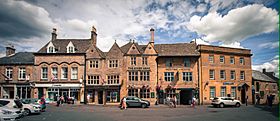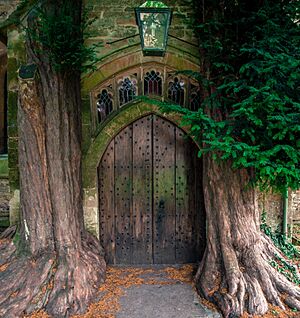Stow-on-the-Wold facts for kids
Quick facts for kids Stow-on-the-Wold |
|
|---|---|
 Market Square |
|
| Population | 2,042 (2011 Census) |
| Civil parish |
|
| District |
|
| Shire county | |
| Region | |
| Country | England |
| Sovereign state | United Kingdom |
| Post town | CHELTENHAM |
| Postcode district | GL54 |
| Dialling code | 01451 |
| Police | Gloucestershire |
| Fire | Gloucestershire |
| Ambulance | Great Western |
| EU Parliament | South West England |
| UK Parliament |
|
Stow-on-the-Wold is a charming market town in Gloucestershire, England. It sits high up on a hill, about 800 feet (244 meters) tall. This special location is where several important roads meet, including the ancient Fosse Way. The Fosse Way was built by the Romans a very long time ago!
Norman lords first created Stow-on-the-Wold. They wanted to create a place where people could easily trade goods. Since 1330, the town has been allowed to hold special fairs by royal permission. Even today, a famous horse fair takes place twice a year, in May and October.
Contents
A Look Back: The History of Stow-on-the-Wold
How Did Stow-on-the-Wold Begin?
Stow-on-the-Wold was first known as Stow St Edward. It was named after a saint, probably Edward the Martyr. People think it started as an Iron Age fort. This was because its hilltop location was perfect for defense. You can find many old forts and burial mounds from the Stone Age and Bronze Age in this area.
Before Stow became a busy market town, a nearby settlement called Maugersbury was the main village. Stow was built on the hilltop to be closer to the crossroads. This helped it become a trading hub. In 1107, King Henry I allowed a weekly market to start. He said that all the money earned from this market should go to Evesham Abbey.

In 1330, King Edward III gave Stow a special permission, called a royal charter. This allowed the town to hold a big, seven-day market every August. People could sell sheep and horses at this market. Later, in 1476, King Edward IV changed this. He allowed two five-day fairs instead. These fairs were held in May and October. The main goal was to make Stow a reliable place for trade. These important fairs took place in the town square, which is still the heart of Stow today.
Stow-on-the-Wold During the English Civil War
Stow-on-the-Wold played a part in the English Civil War. This was a big conflict in England's history. Some battles happened nearby, and the local church, St Edward's, was damaged.
On March 21, 1646, a major battle took place. It was called the Battle of Stow-on-the-Wold. The Royalist army, led by Sir Jacob Astley, was defeated. Hundreds of captured soldiers were held in St Edward's Church. This battle happened about a mile north of Stow. The Royalists first had some success, but the Parliament's forces were stronger. They pushed the Royalists back into the streets of Stow. The fighting ended in the market square, where the Royalists finally gave up.
Stow-on-the-Wold in Modern Times
As the fairs became more famous, the town of Stow grew. Traders sold not only livestock but also many handmade items. The wool trade was always very important. In the 1700s, a writer named Daniel Defoe said that 20,000 sheep were sold in one day! Many narrow paths, called 'tures', run between buildings into the market square. These paths were used to guide sheep to be sold.
Most of the buildings around the market square were built in the 1700s and 1800s. This includes St Edward's Hall, which is now the town's library.
When the wool trade became less important, people started trading horses instead. This tradition continues today. The horse fair no longer takes place in the town square. It is now held in a large field near the village of Maugersbury every May and October. It is still very popular, and the roads around Stow can get very busy with traffic during the fair.
However, the Stow Fair has also caused some debate. Many visitors and traders come, but some are not involved in horse trading. Local shops and pubs used to make a lot of money from the extra customers. But in recent years, many of them close during the fair. This is because of worries about theft or damage.
How Stow-on-the-Wold is Governed
Stow-on-the-Wold is part of the Stow electoral ward. This area also includes the parishes of Maugersbury and Swell. In 2010, about 2,594 people lived in these parishes.
Stow-on-the-Wold has a Parish Council that is very active. It has 10 members who help make decisions for the town.
The Stow ward is represented on the Cotswold District Council by Councillor Dilys Neill. She is from the Liberal Democrat party and was first elected in 2016. The Stow Division is represented on the Gloucestershire County Council by Councillor Mark Mackenzie-Charrington, who is from the Conservative Party.
Economy: What Businesses are in Stow-on-the-Wold?
Scotts of Stow is a well-known company that sells things by mail order. They also have two shops right in the town.
Media: News and Entertainment
Local news and TV shows for Stow-on-the-Wold come from BBC South and ITV Meridian. You can get TV signals from the Oxford and local relay transmitters.
For radio, you can listen to BBC Radio Gloucestershire, Heart West, Greatest Hits Radio South West, and Cotswolds Radio. Cotswolds Radio is a local station for the community.
The town also has its own local newspaper, called the Cotswold Journal.
Transport: Getting Around Stow-on-the-Wold
Several important roads pass through Stow-on-the-Wold:
- The Fosse Way (A429) goes from the M4 motorway (near Chippenham) to the M40 motorway (at Warwick).
- The A424 connects the town center to the A44. This road continues towards Evesham.
- The A436 links Brockworth with Salford, Oxfordshire.
From 1881 to 1962, Stow-on-the-Wold had its own train station. It was part of the Great Western Railway. Now, the closest train station is at Moreton-in-Marsh, which is about 4 miles (6.4 km) away. This station is on the Cotswold Line, which connects Hereford to London Paddington. Train services are provided by Great Western Railway. Another option is Kingham, about 5 miles (8 km) from Stow on the same line.
Local bus services are mainly run by Pulhams Coaches. Key bus routes connect Stow to places like Moreton-in-Marsh, Hook Norton, and Bourton-on-the-Water.
Notable People from Stow-on-the-Wold
Many interesting people have connections to Stow-on-the-Wold:
- Clement Barksdale (1609–1687) was a writer and poet. He was the Rector (a type of church leader) of Stow-on-the-Wold for many years.
- Edmund Chilmead (1610–1654) was a writer, translator, and musician born in the town.
- George Wilkinson (1814–1890) was an architect who designed the Stow-on-the-Wold Workhouse in 1836.
- George Pepall (1876–1953), a county cricketer, was born here.
- Harry Ferguson (1884–1960), a famous engineer and inventor of the Ferguson tractor, passed away in Stow.
- Frederic Bartlett (1886–1969) was an important experimental psychologist and academic. He was born in the town.
- John Howland (1895–1958), another county cricketer, was also born here.
- John Entwistle (1944–2002) was a musician and bass guitarist for the famous band the Who. He bought a house called Quarwood in Stow-on-the-Wold in 1976. His funeral was held at St Edward's Church.
- David Loder (born 1964), a racehorse trainer, was born in the town.
See also
In Spanish: Stow-on-the-Wold para niños


